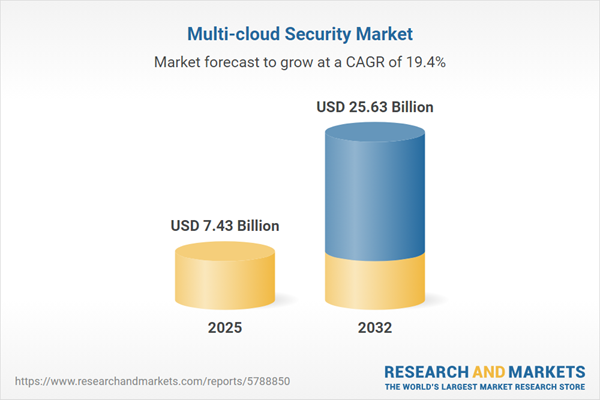Speak directly to the analyst to clarify any post sales queries you may have.
Enterprises accelerating their digital initiatives are facing new and complex multi-cloud security requirements. Senior decision-makers must prioritize adaptive, integrated security approaches to support transformation, ensuring alignment with evolving operational risk and compliance landscapes.
Market Snapshot: Multi-Cloud Security Market Opportunities and Trends
The multi-cloud security market is currently valued at USD 6.21 billion, with projected growth to USD 7.43 billion over the next year. This represents a compound annual growth rate of 19.36%, and the market is expected to reach USD 25.63 billion by 2032. This robust growth reflects enterprises’ migration from traditional perimeter-based security models to flexible, cloud-native solutions that respond to diverse threat environments. As organizations embrace public, private, and hybrid cloud models, the strategic focus has shifted to unified threat management. Compliance drivers and globally distributed operations are prompting demand for comprehensive, integrated security frameworks that support secure, resilient digital expansion.
Scope & Segmentation: Key Areas in the Multi-Cloud Security Market
This report provides actionable insights to help executives navigate the multi-cloud security landscape and make technology decisions that enable compliance and support operational needs. Organizations face a diverse array of risks and technology considerations across the following market segments:
- Component: Managed services, professional services, and advanced security solutions, including cloud access security broker platforms, security posture management, analytics, identity and access management, data protection, and network security. These components underpin enterprise compliance and operational resilience.
- Service Type: Managed services offer continuous oversight, while professional services provide risk assessment, secure migration, consulting, and long-term security planning. Both are critical for maintaining agility amid shifting regulations and threats.
- Deployment Model: Organizations leverage hybrid, private, and public cloud deployments, tailoring their strategies to regulatory requirements, data sovereignty, and integration needs. Deployment choice directly impacts governance structure and data management.
- End Use Industry: Major adopters include financial services, insurance, healthcare, government, defense, information technology, and telecommunications. Each industry faces sector-specific security and regulatory compliance challenges, driving the need for industry-adapted solutions.
- Region: The market spans the Americas (United States, Canada, Brazil), EMEA (Germany, UAE, South Africa), and Asia-Pacific (China, India, Japan, Singapore). Node-level differences in regulatory frameworks and cloud adoption speed shape investment strategies and supplier dynamics across these regions.
- Leading Vendors: Key providers are Palo Alto Networks, Fortinet, Cisco Systems, Check Point Software Technologies, Trend Micro, Broadcom, IBM, Microsoft, CrowdStrike, and Zscaler. These firms supply sector-specific and regionally compliant security solutions to address unique enterprise needs.
Key Takeaways: Strategic Insights for Senior Decision-Makers
- Centralized management tools enable unified oversight and faster threat response across multi-cloud environments, simplifying the complexity of distributed operations.
- Automated, identity-centric security technologies streamline cloud migration and aid in continuous compliance as regulatory requirements shift and business priorities evolve.
- Zero trust principles, utilizing cloud-native solutions, help enterprises adapt to expanding attack surfaces and improve incident response readiness.
- Effective governance models ensure that organizations keep security controls in step with evolving international and sector-specific compliance mandates.
- Vendor selection, focused on proven compliance credentials, mitigates risk in multi-cloud procurement and strengthens supply chain security posture.
- Continuous workforce upskilling and collaboration with trusted providers enhance governance capability and adaptability in responding to distributed cloud challenges.
Tariff Impact: Navigating Economic and Supply Chain Shifts
Anticipated U.S. tariffs in 2025 are prompting enterprises to reevaluate technology partners and sourcing approaches. This shift is leading to increased focus on local supply chains and adoption of software-driven security, reducing reliance on hardware-based solutions and single-source vendors. By revising procurement strategies, organizations seek to manage cost fluctuations, fortify supply chain resilience, and protect business continuity as they scale global cloud operations.
Methodology & Data Sources
Findings are drawn from interviews with executive leaders and comprehensive secondary research. Validation is provided through updates from global regulatory authorities, ensuring relevance and accuracy for multi-cloud security deployment and compliance assessments.
Multi-Cloud Security Market: Why This Report Matters
- Empowers leaders to create agile, adaptive security strategies that reflect both organizational goals and sector compliance imperatives.
- Supports effective evaluation of technology suppliers and ensures compliance across varied deployment models and international regions.
- Facilitates strategic planning and collaboration, enabling organizations to advance secure business transformation as technology and compliance demands shift.
Conclusion
This report delivers practical guidance for executives addressing evolving risk management and compliance in multi-cloud settings, enabling organizations to maintain secure, flexible operations and support enduring digital success.
Additional Product Information:
- Purchase of this report includes 1 year online access with quarterly updates.
- This report can be updated on request. Please contact our Customer Experience team using the Ask a Question widget on our website.
Table of Contents
3. Executive Summary
4. Market Overview
7. Cumulative Impact of Artificial Intelligence 2025
Companies Mentioned
The companies profiled in this Multi-cloud Security market report include:- Palo Alto Networks, Inc.
- Fortinet, Inc.
- Cisco Systems, Inc.
- Check Point Software Technologies Ltd.
- Trend Micro Incorporated
- Broadcom Inc.
- International Business Machines Corporation
- Microsoft Corporation
- CrowdStrike Holdings, Inc.
- Zscaler, Inc.
Table Information
| Report Attribute | Details |
|---|---|
| No. of Pages | 199 |
| Published | October 2025 |
| Forecast Period | 2025 - 2032 |
| Estimated Market Value ( USD | $ 7.43 Billion |
| Forecasted Market Value ( USD | $ 25.63 Billion |
| Compound Annual Growth Rate | 19.3% |
| Regions Covered | Global |
| No. of Companies Mentioned | 11 |









